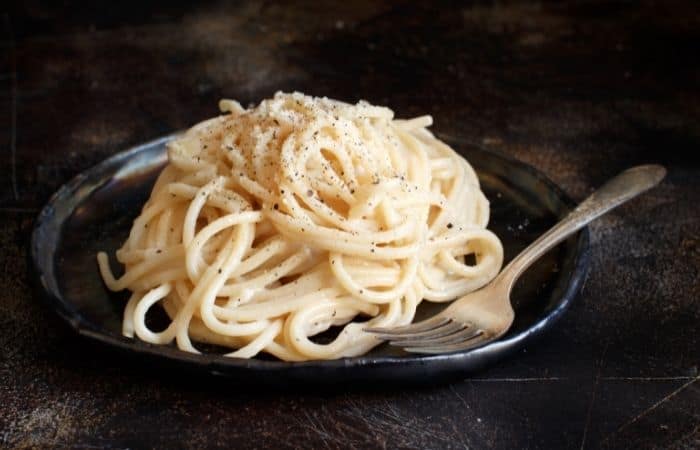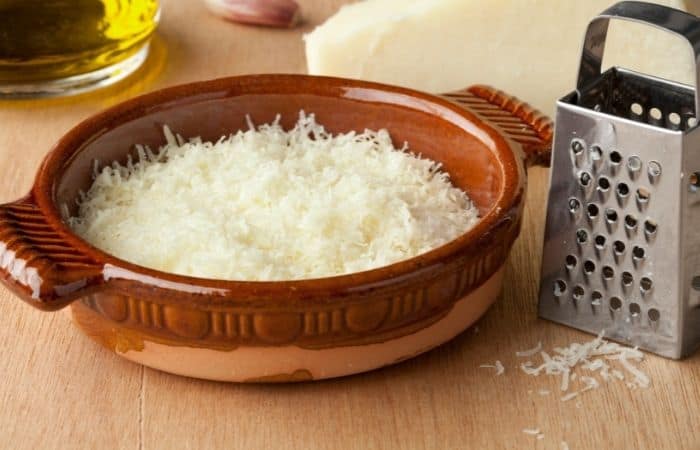What Does Cacio e Pepe Mean in English?
You may be wondering what Cacio e Pepe means in English. It means “cheese and pepper.” It is a pasta dish that is a favorite meal in many Italian homes, and its origin traces back to Rome. To make Cacio e Pepe pasta, you need Pecorino Romano cheese to mix with butter, pasta water, and freshly cracked pepper.

The History of Cacio e Pepe
Pasta Cacio e Pepe is an Italian pasta dish from modern Roman cuisine. It appeared in the Roman cooking frontier in the mid-twentieth century. The most exciting thing is it is a staple food in Rome and all over Italy.
It usually is referred to as the stripped-down cheese and mac of Italy. To conjure this dish in your own kitchen, you only need simple ingredients like cheese, olive oil, butter, salt, and pasta. However, to have an extraordinary one, ensure to get the correct measurements of the ingredients.
Cacio is a local Roman dialect for Pecorino Romano, which is cheese from sheep’s milk. When preparing Cacio de Pepe, add Pecorino Romano to butter to create a creamy sauce.
Can You Substitute Pecorino Romano for Parmesan?
By looking at the name, we have already learned that Cacio means cheese from sheep’s milk. While other people may want to use Parmesan, it is not advisable. Parmesan is not sufficiently flavorful when compared to Pecorino Romano and other Italian cheeses. As much as both kinds of cheese are hard and salty, Pecorino Romano is superior in flavor hence producing a better end result. It is also more assertive, saltier, and pungent.

On the other hand, Parmesan is from cow’s milk and is a bit mild and neutral. However, you may use it if you only have Parmesan and want to make Cacio de Pepe. But, the taste will not be anywhere near Cacio e Pepe prepared with Pecorino Romano.
The Best Pasta to Use for Cacio e Pepe
Cacio e Pepe pasta needs smooth and long noodles that you can bind easily in the sauce. It needs to be thick enough to stand up against the peppery sauce. The noodle shouldn’t be the one that melts away. Below are some of the best kinds of pasta for making Cacio e Pepe:
Bucatini
Bucatini looks like spaghetti but a bit thicker. It has a hole that you can fill with sauce.
Spaghetti alla chitarra
It is also called macaroni alla chitarra, an egg pasta usually common in Abruzzo, Italy. It has a square cross-section of 2-3 mm thick.
Cirilo
This is the thicker version of citarra. Its thickness is double that of spaghetti.
Spaghetti
You can have your spaghetti Cacio e Pepe, using spaghetti. We like it because it is easy to find and also works well.
Tonnarelli
This is the traditional pasta for Cacio de Pepe. It is an egg pasta from Lazio, Italy, with a thickness of 2-3mm. It is the best and so delicious!
How to Stop the Cheese in Cacio e Pepe from Clumping
When preparing Cacio e Pepe, it may end up clumping. To prevent it from clumping, follow the following tips:
Use high-quality ingredients
High-quality ingredients are essential when preparing Cacio e Pepe. For instance, Pecorino Romano has to be present. However, you can import Pecorino Romano that you can afford.
Grate cheese by yourself
Do not use pre-grated cheese, as it will make your sauce clumpy. There are also pre-packaged cheeses that have an anti-clumping coating that prevents them from melting well. To avoid all these, freshly grate your Pecorino Romano cheese for a perfect Cacio e Pepe.
Grate cheese first
Always ensure that you grate your cheese first before you commence cooking. You may not have time to grate cheese after you add hot water to the butter mixture. The cheese needs to be added immediately, failure to which will result in clumping. It is advisable to grate the cheese while the pasta water is boiling to save time.
Use finely grated cheese
The small holes on your grater are the best for grating the cheese. What we need is powdery Pecorino Romano like the ones from the stores. A clump quickly happens with cheese that has been grated on large holes as they take longer to melt.
Do not increase the amount of water for cooking pasta
Cacio e Pepe comes out best if it is prepared in the concentrated starchy pasta water. Increasing the amount of water will make the pasta water less starchy.
Don’t reserve pasta water early
Pasta water becomes more starchy as it continues to cook. Therefore, it would be best not to reserve the water before it releases more starch.
Allow the pasta water to cool
Hot pasta water is not suitable for the cheese as it will cause it to seize. Instead, let the water cool for at least 3 minutes before adding it to the butter. Alternatively, melting the cheese over low heat bit by bit ends up providing a gradual melting process.
Don’t add all cheese at once
Whisk the cheese into the sauce little by little. This will make it melt evenly because of the increased liquid surrounding it.
Don’t confuse cheese not melting with clumping
Your cheese may not melt instantly as soon as you put it in the butter/water mixture. Instead, it will gradually melt over low heat as you whisk it.
Continue to whisk until the cheese melts
Your cheese melting depends on the quality of the cheese, the size of the pan, and the actual heat of the sauce. Continue whisking until the cheese melts.
A Simple Cacio e Pepe Recipe to Try at Home
Do you want to make your Cacio e Pepe at home? Then, try this amazing Italian recipe!
Cacio e Pepe for Two
Ingredients
- 6 oz Pasta
- 1 Tsp. Freshly cracked black pepper.
- 3 Tbsp. Unsalted butter, cubed
- 1/3 cup tiny grated Pecorino Romano cheese
Procedure
- Boil three-quarters of the water and then season with salt. Add pasta and let it cook while stirring until 2 minutes before it becomes tender—drain and reserve a ¾ cup of boiled pasta water.
- Over medium heat, melt 2 tablespoons of butter in a large pan. Add pepper and cook while swirling the pan for about 60 seconds.
- Add 1/2 a cup of pasta water. Let it simmer. Then, add pasta and the remaining butter. Remove the pan from the heat, add Pecorino, stir and toss it until the cheese melts. The sauce will coat the pasta and if it looks dry, add more pasta water.
- Transfer your pasta to bowls and serve!
The Proud Italian’s Top Tips for Making Authentic Cacio e Pepe
To come up with the best Cacio e Pepe, here are some more helpful tips:
Use Salt Water
Salting the pasta water is vital as it makes the pasta and water tasty. This translates to a more flavorful Cacio e Pepe.
Stir the pasta frequently as it cooks
Stir the pasta as it cooks. If you don’t, it will stick to the pot. At the same time, you will need to melt the butter and saute the pepper.
Don’t overcook the pasta
Mushy or overcooked pasta can ruin your Cacio e Pepe. Cook until barely al dente, or until it has a bite. Remember it will continue to cook when you combine it with your sauce.
Know when Pasta is Done?
You will only find out by tasting a strand of it. Use a slotted spoon to remove it from the pan and rinse it before tasting. You don’t want to burn your tongue! You can start tasting at 4 minutes into the cooking time.
Use a large pan
Get a large pan that can hold all the ingredients. There should be enough room to twirl and toss without having to whip the sauce everywhere.
Use freshly cracked pepper
Don’t use pre-ground pepper. Freshly cracked pepper is richer in flavor than pre-ground pepper that has been exposed to oxygen.
Toast pepper first, don’t add later
Add pepper directly to the olive oil and butter. Toasting the pepper will evenly spread its flavor to the sauce. Adding after will mean uneven distribution of flavor.
Thin sauce
If you notice your pasta looks dry after combining with the sauce, add more pasta water little by little.
Let the pasta rest before serving
To make the sauce thicken and the flavors develop, allow the pasta to rest before serving.
Other Cacio e Pepe Variants
You can use Cacio e Pepe as a springboard for other variations. For example, you can add the following to your Cacio Pepe recipe:
Crushed red pepper flakes: Saute a pinch of red pepper flakes together with black pepper.
Seasonings: add seasoning like thyme, dried basil, or oregano.
Flavorings: Add a splash of pesto or lemon juice.
Sun-dried tomatoes: Replace olive oil with oil from the sun-dried tomato jar and saute the dried tomatoes in butter with black pepper.
Fresh or Fire-roasted diced tomatoes: Saute chopped fresh Roma tomatoes in butter or stir in fire-roasted diced tomatoes at the end of cooking.
Vegetables: Add chopped vegetables like bell peppers, asparagus, mushrooms, green beans, zucchini and saute them in butter or olive oil until crispy. If you have roasted vegetables, you can add them directly to pasta at the end of cooking.
Greens: Stir in kale or spinach directly into the pasta to wilt.
Protein: At the end of cooking, stir in any cooked protein like bacon, sauteed shrimp, buttery salmon, or Italian sausage.
How to Store Cacio e Pepe
The aforementioned Cacio e Pepe recipe is not perfect for a large serving. Most of the time, you won’t have leftovers. But, in case you have, store it in an airtight container in the refrigerator. You can preserve it for up to five days.
Reheating Cacio e Pepe
You can reheat Cacio e Pepe on a stovetop or in a microwave.
Heating Instructions
Stove
If you have more significant portions, reheat pasta on a stove. Add a splash of water to make the sauce thin. The sauce becomes thick after staying in the refrigerator.
Microwave
Add some water to your serving, don’t stir in yet until after microwaving for a minute. Then, continue reheating at intervals of 30 seconds until it is warmed.
What to Serve With Cacio e Pepe
Cacio de Pepe is a great meatless entree, and you can also serve it as an aside. Below are ideas on how to serve it:
Protein: If you serve Cacio e Pepe as a side, pair it with lemon pepper chicken, shrimp scampi, pesto chicken, pepper chicken, Caprese Chicken, and spice-rubbed steaks.
Salad: Creamy Cacio e Pepe pairs well with salads like pear, roasted butternut squash, green bean, cucumber-tomato, and apple salad.
Vegetables: These roasted vegetables go well with Cacio e Pepe: Parmesan asparagus, butternut squash, carrots, cauliflower, and Parmesan broccoli.
Fruit: Fresh fruit is always the best with pasta. Use grapes, melon e.t.c.
Bread: Garlic bread is so good with Cacio e Pepe.
Pasta Away!
From the discussion above, you can tell that the Cacio e Pepe recipe is one of the simplest. With only four main ingredients, and in 20 minutes, you will have your Cacio e Pepe delicacy.
Perché non provarlo? (Why not try it?)

Community of passionate writers and content creators who share a love for Italian heritage, culture, travel, food, and the Italian-American community. Our mission is to celebrate Italy’s rich history and traditions and connect with others who share the same passion.

